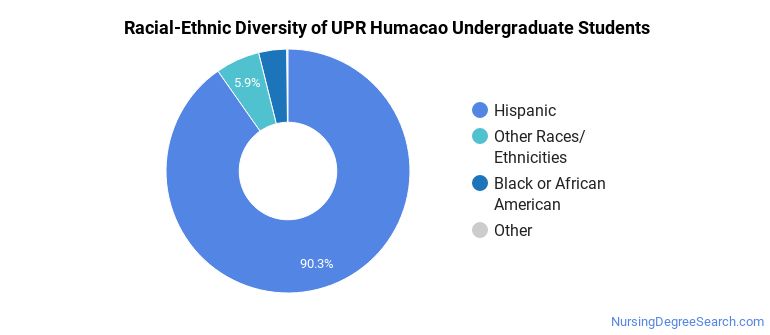University of Puerto Rico - Humacao Nursing Programs
Located in Humacao, Puerto Rico, University of Puerto Rico - Humacao is a public institution. Humacao is considered a suburb and offers tranquility and safety near the excitement of a city center.
Where Is University of Puerto Rico - Humacao?

Contact details for UPR Humacao are given below.
| Contact Details | |
|---|---|
| Address: | Call Box 860, Humacao, PR 00792 |
| Phone: | 787-850-0000 |
| Website: | www.upr.edu |
How Do I Get Into UPR Humacao?
You can apply to UPR Humacao online at: www.upr.edu/admisiones/
Admission Requirements for UPR Humacao
| Submission | Required? |
|---|---|
| High School GPA | 1 |
| High School Rank | 3 |
| High School Transcript | 1 |
| College Prep Program | 3 |
| Recommendations | 3 |
| SAT or ACT Scores | 3 |
| TOEFL | 3 |
How Hard Is It To Get Into UPR Humacao?
Approximately 36% of accepted students are men and 64% are women. The acceptance rate for men is 54%, and the acceptance rate for women is 53%.
Can I Afford University of Puerto Rico - Humacao?
University of Puerto Rico - Humacao Undergraduate Student Diversity

Gender Diversity
Of the 2,781 full-time undergraduates at UPR Humacao, 34% are male and 66% are female.

Racial-Ethnic Diversity
The racial-ethnic breakdown of University of Puerto Rico - Humacao students is as follows.

| Race/Ethnicity | Number of Grads |
|---|---|
| Asian | 0 |
| Black or African American | 103 |
| Hispanic or Latino | 2,510 |
| White | 5 |
| International Students | 0 |
| Other Races/Ethnicities | 163 |
Geographic Diversity
Puerto Rico students aren't the only ones who study at University of Puerto Rico - Humacao. At this time, 3 states are represented by the student population at the school.
University of Puerto Rico - Humacao Nursing Concentrations
The table below shows the number of awards for each concentration.
| Major | Bachelor’s | TOTAL |
|---|---|---|
| Registered Nursing | 49 | 49 |
| TOTAL | 49 | 49 |
References
*The racial-ethnic minorities count is calculated by taking the total number of students and subtracting white students, international students, and students whose race/ethnicity was unknown. This number is then divided by the total number of students at the school to obtain the racial-ethnic minorities percentage.
More about our data sources and methodologies.
